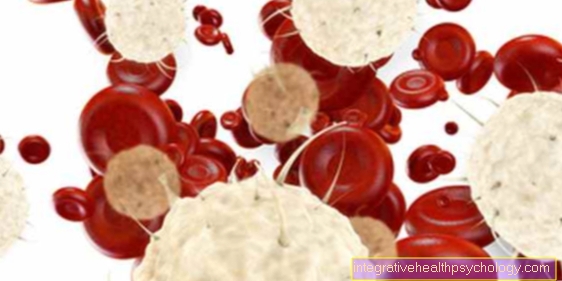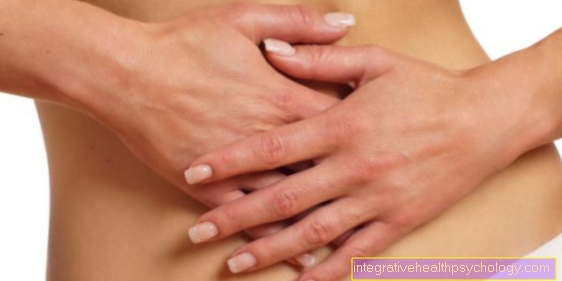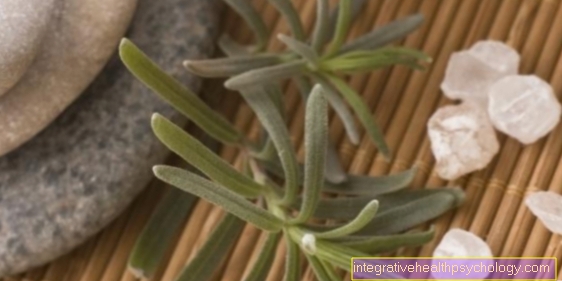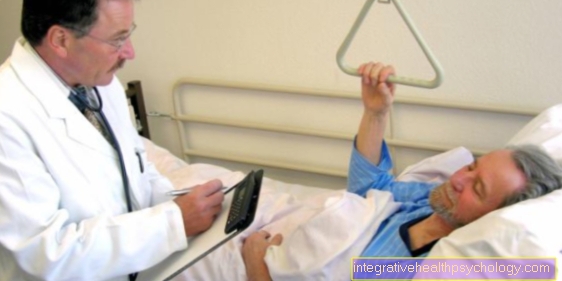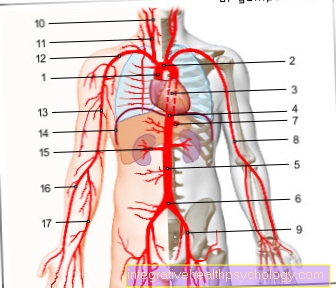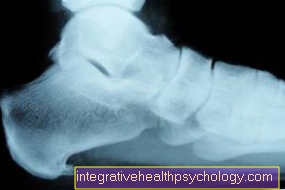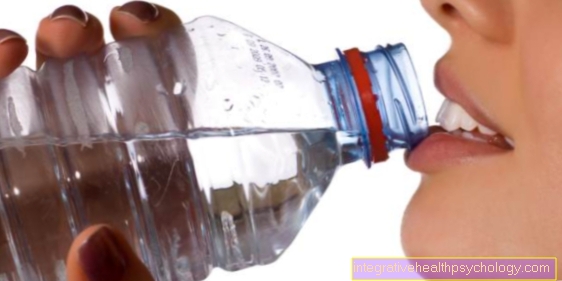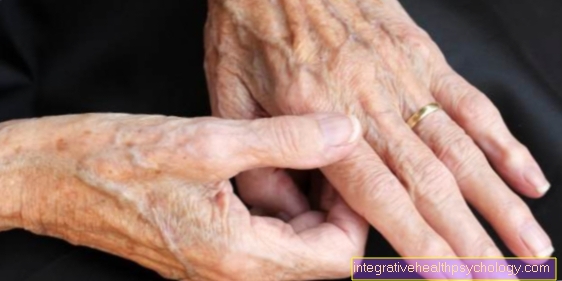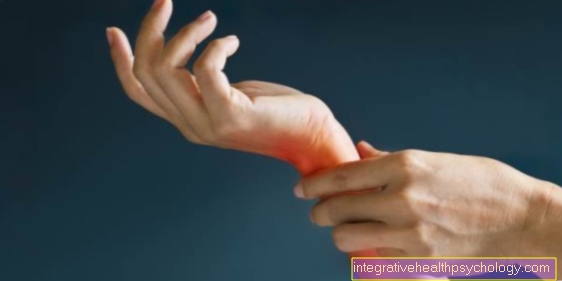Torn anus
definition
The torn anus is a common one painful tear in the mucous membrane of the anal canal of the anus, which is called the anoderm. Typically (in about 90% of cases) the posterior commissure of the anal canal is affected. The rear side of the anus, i.e. the side of the anus facing the tailbone, is referred to as such. Typical symptoms of the torn anus are next to partly severe burning pain when defecating, itching (Pruritus) and light red blood in the stool or on the toilet paper.
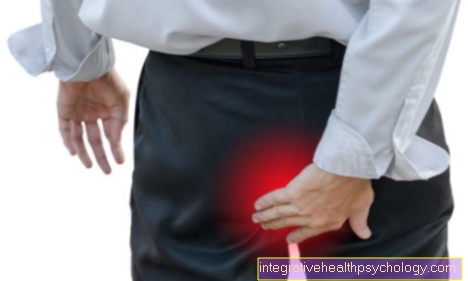
People between the 30 and 40 years of age are particularly often affected by a torn anus; Generally, however, a torn anus occurs at any age and in both sexes about the same time. In children, a torn anus is also more common than average.
Regarding the course of the disease can be between a acute and chronic form of the torn anus can be distinguished. The former usually heals after a few weeks, while the chronic form results from poor wound healing and the resulting scarring and thickening of the affected skin area. Chronic tears of the anus usually require surgical intervention under short anesthesia.
Please also read our article on this Anal fissure
causes
How exactly a torn anus arises is still not fully understood. With a high probability, however, it is Consequence of various factorsthat influence each other in the course of the disease. This includes, among other things, those inherently more likely poor blood supply to the anoderm the posterior commissure of the anus, which causes tissue damage to heal more slowly and infections less effectively.
However, the first trigger for the anoderm to tear is usually simple hard bowel movements in the context of chronic constipation. This necessitates strong pressing during bowel movements, which in turn can cause the first cracks in the mucous membrane. On the other hand, tears will also occur at pre-existing inflammation, such as Eczema of the anal mucosa strongly favored. These are mainly included inflammatory bowel disease which are typically associated with chronic diarrhea due to the permanent inflammation. As a result of the inflammatory process, the anoderm loses its elasticity and becomes more susceptible to irritation from the pathologically increased stool. This can also cause other intestinal diseases associated with diarrhea, such as one that has not been treated Lactose intolerancefavor a torn anus.
Please also read our article on this Inflammation of the anus
Apart from that, certain also favor sexual habitslike anal intercourse or inserting objects into a torn anus. Ask other risk factors hemorrhoids and a lifestyle that is dominated by sedentary activities increased sphincter tone, so a pathological tension of the sphincter muscle of the anus, the development of a torn anus.
Symptoms
A torn anus is usually great with some characteristic symptoms so that a fairly reliable diagnosis can be made based on this. One of the typical is one bright, stabbing pain when irritated the affected mucosal area. During bowel movements, a persistent, burning pain. This leads to tension in the sphincter muscle up to anal cramps, through which the stool can only be forcibly released in a thin cord, described as being strong as a pencil.
Can in the chair light red blood to be found. The patient usually first notices this slight bleeding on the toilet paper.
Please also read our article on this Blood in the stool
The bowel movement can thus become a frightening procedure for the person concerned, making it one Avoidance behavior and finally Constipation or an intensification of this can occur, which further intensifies the problem. Characteristically, it is accompanied by rest or when running Itching of the anus (Pruritus) on.
Pain in a torn anus
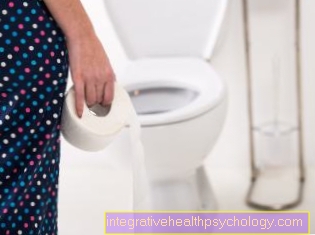
A torn anus goes with it very characteristic pain hand in hand. These can best be described as bright and piercing describe when there is irritation of the damaged mucous membrane, for example when running. The pain when defecating however, dominates rather than one burning, persistent painwhich leads to tension in the sphincter (Sphincter ani) up to anal cramp, which makes bowel movements even more difficult.
Please also read our article on this Pain in the anus
Treatment of severe pain can be achieved through the Applying an ointment with the addition of a local anesthetic after a bowel movement. Can also be helpful special suppositories be. These are applied to the affected area using a so-called applicator. Some doctors also choose this for very stressful pain Injecting a local anesthetic. Occasionally, too Painkillers prescribed as ibuprofen or paracetamol.
In the longer term, however, it is more important in terms of pain relief through a Adaptation of eating and drinking habits To achieve a soft and shaped stool continence in order to facilitate bowel movements and to allow the mucosal defect to heal quickly. Above all, one is important here good anal hygiene. This can be achieved by gently cleaning the anal area with a washcloth soaked in lukewarm water and a little pH-neutral soap after a bowel movement. Furthermore, depending on the degree of the fissure further therapy methods available in order to achieve rapid healing of the wound and thus pain relief.
Read our articles on this Painful bowel movements and Pain after a bowel movement
diagnosis
A torn anus is typically diagnosed using a Inspection of the anus in combination with those made by the patient Information about symptoms, previous illnesses and bowel habits. The tear can usually be found at 6 o'clock in the so-called lithotomy position, i.e. lying on your back towards the tailbone. On the other hand, tears lying on the side or in groups, which tend to suggest other diseases, are very atypical. At the Feeling the tear usually gets involved painful ulcer or a coarse strand of tissue determine. A Proctoscopy which is usually only possible under anesthesia due to the pain.
When diagnosing a torn anus, the Presence of hemorrhoids be thought. However, these can usually be ruled out based on the location of the mucosal defect. In fact, a torn anus is often misdiagnosed as a hemorrhoid, so unnecessarily extensive treatment is started.
therapy
An untreated cracked anus may take some time to heal. However, as they do in most cases very uncomfortable for the person concerned are and also that Risk of chronification of the mucosal defect, therapy is advisable in many cases. A distinction must be made between an acute and an already chronically torn anus.
The first step in treating an acute fissure is the Regulation of bowel movements. The aim should be one soft, malleable consistency of the chair. A diet rich in fiber and an adequate supply of fluids are important tools for combating constipation. In the case of long-lasting diarrhea, the cause should be addressed.
Strong, caused by the tear in the mucous membrane Painafter every bowel movement with a locally numbing ointment be treated. Furthermore is a good anal hygiene important for the wound to heal quickly. A washcloth soaked in lukewarm water and a little pH-neutral soap can be used for this after a bowel movement. A bidet, for example, is also ideal for anal cleaning. If you follow these simple steps, most freshly torn anus will heal completely within six to eight weeks with no problem.
The chronic form the torn anus, however, requires further measures. Those fissures are considered chronic, their Symptoms persist for more than two months. Here too she plays Stool regulation an important role, which in addition to food intake through laxative drugs is achieved.
There Anal cramps however, if the disease is prolonged, it must also represent a great burden and contribute to maintaining the disease Adjusts the tone of the sphincter become. This is achieved through the use of the active ingredients nitroglycerin, nifedipine or diltiazem from the group of Calcium antagonists reached. These remedies, which are very often used for high blood pressure, have a vasodilating effect and thus contribute to the relaxation of the sphincter. It is used three to four times a day for up to twelve weeks in the form of an ointment.Alternatively, active substance-carrying plasters and higher concentrated ointments are available, which have to be applied less frequently.
About 80% of all patients are symptom-free after six to eight weeks using this treatment regimen. Should despite good stool regulation and consistent application of the ointments and insufficient healing the fissure is reached surgical intervention represents the next stage in the therapy process.
This takes place under anesthesia cut out (Excision) the wound including any scarred tissue. The resulting smooth-edged wound is usually not sutured. For this reason, complete wound healing then takes another four to six weeks. Stretching or even cutting the anal sphincter, as was done during anesthesia until a few years ago, is generally considered to be out of date.
You might also be interested in: Therapy of hemorrhoids
Operation on a torn anus
If the symptoms caused by the torn anus persist for more than 2 months despite consistent application of the ointment and adequate stool regulation, there is one chronified form of the torn anus. Here the damaged mucous membrane is no longer able to heal on its own and begins instead untargeted scarring. It comes to skin growths with the formation of concise skin folds, the so-called outpost folds. The patient can usually feel the rough edges of the wound himself. Conservative therapy no longer promises a cure here. In order to avoid further complications and to be able to alleviate the discomfort is a surgical intervention necessary.
The so-called fissurectomy, translated as the cutting out of a skin tear, is nowadays usually carried out on an outpatient basis under short anesthesia or in some cases in the case of older patients as part of a short inpatient admission. The entire wound with the surrounding scar tissue is removed. However, the newly created, smooth-edged wound is not sutured, so that the targeted wound healing that follows requires another four to six weeks. Follow-up treatment is again carried out using the conservative methods described above. Complications are very rare, so repeated or more serious interventions are usually not necessary.
Suppository for a torn anus
To local treatment A number of different ointments, gels, but also suppositories are available for a torn anus. In addition to active ingredients such as nifedipine or diltiazem, which have a vasodilating and thus relaxing effect on the anal sphincter, are also available Suppositories to choose which locally pain reliever Act. Their effect is based on commercial local anesthetics, above all the medicinal substance Lidocaine.
Through its effect, not only one finds Pain reliefbut also one Relief from itching instead of. Lidocaine has a very fast onset of action and a long duration of action. Since it hardly causes allergic reactions and generally very few side effects Lidocaine is the local anesthetic of choice for a torn anus. In addition to normal suppositories, the active ingredient can also be applied in the form of anal tampons. These ensure a more targeted and more even delivery of the active ingredient.
Homeopathy for a torn anus
It usually takes several weeks until the treatment of a torn anus is free of symptoms. During these weeks, the patient suffers from stressful pain even with everyday movements and especially when defecating. After this conventional medical treatment attempts initially no improvements seem to bring some patients to take it homeopathic remedies.
At this point, however, it should be mentioned on the subject of homeopathy in general that to date no meaningful studies on the effects of homeopathic remedies exist. The theoretical foundations of homeopathy even contradict current medical, chemical and physical knowledge. At the same time, the homeopathic remedies offered are not regulated by the currently applicable Medicines Act, but are subject to their own, scientifically unjustifiable regulations.
Nonetheless, there are a number of different homeopathic remedies for treating a torn anus. Depending on the underlying cause of the fissure, special preparations are recommended. Since the list of these means offered and their recommendations for use is quite long, reference should be made at this point to pages that are specifically dedicated to this topic. In any case, caution is required if the pain intensifies or worsens. In this case, it is always advisable to seek medical advice.
You might also be interested in: Homeopathy for hemorrhoids
Torn anus in the child
One of the most common reasons to see a doctor in childhood is bleeding from the rectum. With the help of a thorough medical history and physical examination the list of possible diagnoses can usually be narrowed down here. By far most common cause of blood in the stool of children however remains the torn anus. At two percent, it is much less common, but still to be considered as a differential diagnosis bleeding polyp in the large intestine. Other causes of rectal bleeding in children, such as anal mucosal prolapse, are very rare.
As in adults, causes a torn anus in children characteristic symptoms. In addition to fresh blood on the toilet paper, these include painful bowel movements and a Itching of the anus in peace. The most common cause of the small tears in the anal mucosa Constipation in children represent.
Because of this, a Regulation of bowel movements important for the child. Special swelling agents that keep the child's stool soft can be used for this. Lactulose can, for example, be used on babies. Larger children, however, will mostly Macrogol prescribed.
Additionally can Ointments promote the wound healing process, as well as relieve pain. The latter is important so that the child does not develop fear of defecation, which would result in holding back the stool and the consequence of further constipation.
The treatment of the torn anus in children is essentially the same as that of fissures in adults. Nevertheless, care should be taken to ensure that all medicines are purchased in doses appropriate for children.




